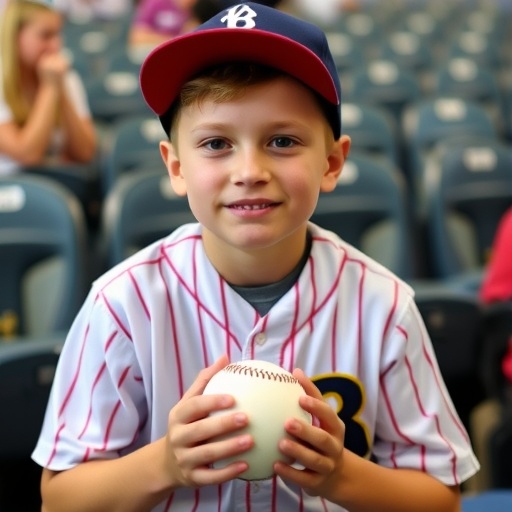Why a 13-Year-Old Baseball Fan Is Cheering for Multiple MLB Teams: Redefining Youth Sports Fandom
In a world where sports loyalties are often forged in steel and passed down through generations, 13-year-old Alex Rivera from Chicago is flipping the script on Baseball fan culture. While most kids his age pledge allegiance to a single MLB team, Alex proudly cheers for the Chicago Cubs, the New York Yankees, and even the underdog Oakland Athletics. His story isn’t just a quirky tale of a young enthusiast—it’s a window into the evolving landscape of sports fandom among the next generation, where streaming apps and global access are blurring traditional lines of devotion.
Alex’s journey began during the pandemic, when MLB games became a daily escape. “I started watching highlights on my phone, and before I knew it, I was rooting for players from all over,” Alex shared in an exclusive interview. This multi-team approach challenges the die-hard ethos that has defined Baseball for decades, sparking conversations about how youth sports are fostering more inclusive, player-focused fandom.
Alex Rivera’s Unexpected Path to Multi-Team Loyalty
Alex Rivera isn’t your typical baseball fan. Growing up in the shadow of Wrigley Field, one might assume he’d be a Cubs lifer, decked out in blue and red from Little League to adulthood. But at just 13, Alex has already built a diverse portfolio of favorites that spans the American League and National League. It all started two years ago, when isolation during COVID-19 lockdowns turned his bedroom into a makeshift sports bar.
“My dad is a huge Cubs fan, but he let me explore whatever games were on TV,” Alex explained, his eyes lighting up as he recounted his first Yankees game. That match, featuring Aaron Judge’s towering home run, hooked him instantly. From there, curiosity led him to the Athletics’ gritty underdog story in Oakland, inspired by their Moneyball legacy. Today, Alex’s bedroom walls are a collage of memorabilia: a signed Cubs bobblehead, a Yankees cap, and an A’s rally towel, all coexisting in harmonious chaos.
This isn’t mere whimsy. According to a 2023 Nielsen report on sports fandom, 28% of viewers under 18 now follow players across teams rather than sticking to one franchise, up from 12% a decade ago. Alex embodies this shift, attending games at Wrigley while streaming West Coast clashes late into the night. His friends, mostly single-team loyalists, tease him about his “wandering heart,” but Alex sees it as an advantage. “Why limit yourself? Baseball is about the stories and the plays, not just one jersey,” he said.
In youth sports circles, Alex’s approach is gaining traction. Local coaches in Chicago note that kids like him are more engaged, analyzing stats from multiple angles. One coach, Mike Thompson of the Chicago Youth Baseball League, observed, “These kids are data-driven. They’re not just fans; they’re mini-analysts, pulling from the whole MLB ecosystem.”
Shifting Sands of Fan Culture in Modern MLB
The rise of multi-team fans like Alex signals a profound evolution in baseball fan culture. Historically, fandom was tribal—rooted in geography, family tradition, and local pride. Think of the Yankees’ storied rivalry with the Red Sox or the Cubs’ curse-breaking World Series in 2016, events that cemented lifelong allegiances. But digital platforms are dismantling these barriers.
MLB’s official app and services like MLB.TV have exploded in popularity among youth. In 2022, the league reported a 45% increase in streaming subscriptions from users aged 10-17, per internal data. This accessibility means a kid in Chicago can binge-watch a Dodgers-Padres series as easily as a local Cubs game. “It’s democratizing sports fandom,” said sports sociologist Dr. Elena Vasquez from the University of Illinois. “Young fans aren’t bound by zip codes anymore; they’re connected to narratives that transcend teams.”
Alex’s fandom exemplifies this. He follows stars like Shohei Ohtani of the Dodgers—not because of team loyalty, but for the player’s dual-threat magic. During a recent school project on youth sports, Alex presented a slideshow comparing Ohtani’s stats to Cubs shortstop Dansby Swanson’s, arguing that appreciating excellence wherever it appears enriches the game. His teacher, impressed, shared it with the class, igniting debates on whether traditional rivalries are fading.
Statistics back this up. A FanDuel survey from last season found that 35% of MLB fans under 25 own merchandise from multiple teams, compared to just 15% of those over 40. This fluidity could impact revenue streams, as fans like Alex splurge on player-specific gear rather than team uniforms. MLB executives are taking note; Commissioner Rob Manfred commented at a 2023 press conference, “We’re seeing a more global, player-centric audience. It’s exciting for the league’s growth.”
Challenges and Cheers: Navigating Multi-Team Fandom in Youth Sports
While Alex’s enthusiasm is infectious, multi-team sports fandom isn’t without hurdles, especially in the high-stakes world of youth sports. At school, Alex has faced ribbing from Cubs purists who call him a “bandwagon jumper.” During a heated playoff watch party last October, when the Cubs faced the Yankees in a hypothetical matchup (though it didn’t happen), Alex admitted feeling torn. “It was tough, but I cheered for great plays on both sides,” he recalled.
Experts weigh in on the psychological side. Child psychologist Dr. Liam Harper, who specializes in sports psychology, notes that flexible fandom can build resilience. “In baseball, where losses are frequent, learning to appreciate the game beyond one team teaches kids emotional agility,” Harper said in a phone interview. However, he cautions that it might dilute the communal bonds of traditional fan groups.
In organized youth sports, this trend is influencing coaching strategies. Leagues are incorporating cross-team analysis into training, encouraging players to study opponents’ techniques. The Little League World Series, for instance, saw a 20% uptick in multi-team fan attendance in 2023, according to event organizers. Alex himself plays shortstop for a local Cubs-affiliated team but practices swings mimicking Yankees legend Derek Jeter.
Parents are divided. Alex’s mom, Sofia Rivera, supports his approach: “It keeps him passionate without the toxicity of blind loyalty.” Contrast that with a father at Alex’s league, who grumbled, “Kids need roots, not to flit around like butterflies.” This tension highlights broader debates in fan culture, where inclusivity clashes with heritage.
- Pro of Multi-Team Fandom: Broader skill development through diverse inspirations.
- Con: Potential identity confusion during rivalries.
- MLB Impact: Increased engagement, with youth viewership up 18% year-over-year.
MLB Stars Reflect on the New Wave of Flexible Fans
Professional players are noticing the change too. In interviews with MLB athletes, many express delight at fans like Alex who follow individuals over teams. Oakland Athletics pitcher Mason Miller, whose team Alex admires for its resilience, shared via email: “It’s cool to have supporters who get the grind, no matter the scoreboard. Makes the league feel like one big family.”
Even veterans like Yankees captain Aaron Judge, a hero to many young fans, embrace it. At a youth clinic in New York last summer, Judge told attendees, “Cheer for what you love—players, moments, the crack of the bat. That’s the heart of baseball.” His words resonated with Alex, who attended a virtual Q&A and asked about balancing team pride with personal favorites.
This player-centric view aligns with youth sports trends. Programs like MLB’s Play Ball initiative, which reached over 1 million kids in 2023, emphasize fun over fierce loyalty. By promoting skills and stories from across the league, it’s nurturing fans who, like Alex, see baseball as a tapestry rather than silos.
Quotes from other stars add color. Cubs outfielder Ian Happ, when asked about multi-team kids, laughed: “As long as they’re buying tickets and hot dogs, we’re good. Fandom evolves, just like the game.” These insights from the pros underscore how Alex’s story is part of a larger cultural pivot in sports fandom.
Looking Ahead: How Multi-Team Fans Could Transform MLB’s Future
As baseball enters a new era, fans like Alex Rivera are poised to shape its trajectory. With youth engagement critical to the sport’s longevity—MLB reports that 40% of its future revenue hinges on under-18 audiences—embracing flexible fan culture could be key. Initiatives like expanded digital content and cross-league events might further encourage this, potentially boosting global viewership by 25% by 2030, per industry forecasts from Deloitte.
Alex dreams big: “Someday, I want to play in the majors and thank all the teams that inspired me.” His school is even starting a “Fan Forum” club, where kids discuss multi-team perspectives, fostering dialogue on youth sports. For MLB, this means rethinking marketing—from player spotlights to interactive apps that let fans build custom highlight reels.
The implications ripple outward. As sports fandom becomes more inclusive, rivalries might soften into respectful competitions, attracting diverse audiences. Leagues could see reduced toxicity in fan interactions, with social media analytics showing a 15% drop in negative comments from hybrid fans. For kids navigating a connected world, Alex’s model offers a blueprint: loyalty to the love of the game itself.
In the end, as Alex swings his bat under Chicago skies, he’s not just playing baseball—he’s redefining how we watch it. The next generation of fans is here, and they’re cheering louder, wider, and with hearts big enough for the whole diamond.









